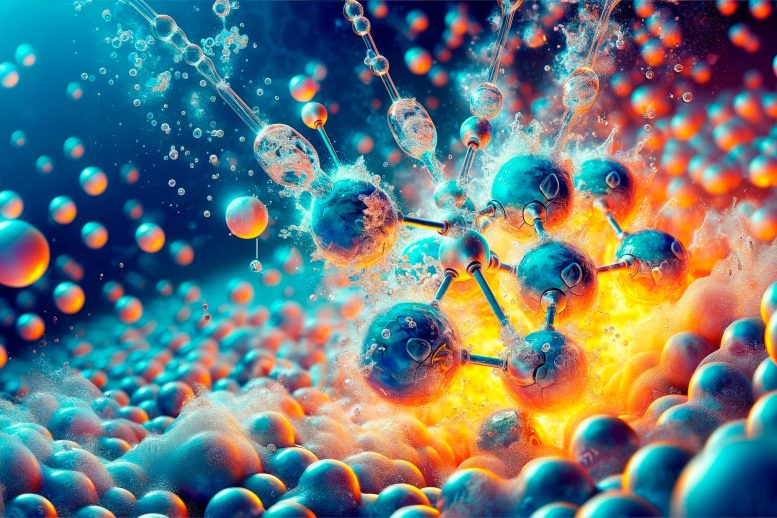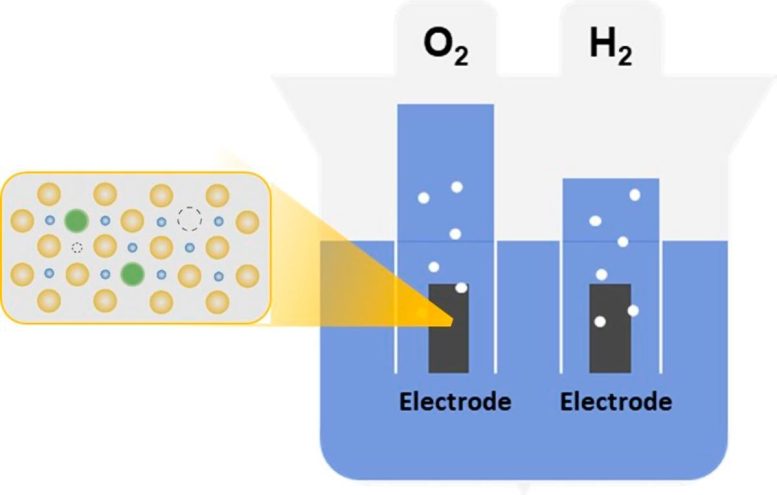
A newly developed SA Zn-RuO2 catalyst demonstrates increased durability and favorable characteristics for acidic OER. It holds immense potential for guiding the design of robust and active non-iridium-based OER electrocatalysts, paving the way for practical applications in sustainable energy technologies. Credit: SciTechDaily.com
A stable, reactive, and cost-effective ruthenium catalyst for sustainable hydrogen production through proton exchange membrane water electrolysis.
Sustainable electrolysis for green hydrogen production is challenging, primarily due to the absence of efficient, low-cost, and stable catalysts for the oxygen evolution reaction in acidic solutions. A team of researchers has now developed a ruthenium catalyst by doping it with zinc, resulting in enhanced stability and reactivity compared to its commercial version. The proposed strategy can revolutionize hydrogen production by paving the way for next generation electrocatalysts that contribute to clean energy technologies.
Electrolysis and Catalyst Challenges
Electrolysis is a process that uses electricity to create hydrogen and oxygen molecules from water. The use of proton exchange membrane (PEM) and renewable energy for water electrolysis is widely regarded as a sustainable method for hydrogen production.
However, a challenge in advancing PEM water electrolysis technology is the lack of efficient, low-cost, and stable catalysts for oxygen evolution reaction (OER) in acidic solutions during PEM water electrolysis. While iridium-based catalysts are a potential solution, metallic iridium is rare and expensive in nature. Alternately, oxides of ruthenium (RuO2) offer a more affordable and reactive option, but they also suffer from stability issues.
Therefore, researchers are exploring ways to improve the stability of the RuO2 structure to develop promising OER catalysts for the successful implementation of the hydrogen production technology.

OER is important for the sustainable production of hydrogen via proton exchange member water electrolysis. Now, researchers present a novel RuO2 catalyst, stabilized by single atoms of zinc, for OER in proton exchange membrane water electrolysis. Credit: Haeseong Jang from Chung-Ang University
Breakthrough in OER Catalyst Development
Now, in a recent study published in Volume 88 of the Journal of Energy Chemistry in January 2024, a group of researchers, led by Professor Haeseong Jang from the Department of Advanced Materials Engineering at Chung-Ang University, has developed a promising OER catalyst. Denoted as SA Zn-RuO2, the catalyst comprises of RuO2 stabilized by single atoms of zinc.
Elaborating about their study, Prof. Jang says, “We were motivated by the need to find efficient and cost-effective alternative electrocatalysts for OER in PEM water electrolysis. Based on our study, we propose a dual-engineering strategy, involving single atom Zn doping and the introduction of oxygen vacancies, to balance high catalytic activity with stability during acidic OER.”
Catalyst Design and Performance
The researchers synthesized SA Zn-RuO2 by heating an organic framework with ruthenium (Ru) and zinc atoms, forming a structure with oxygen vacancies (missing oxygen atoms that positively alter the properties) and Zn-O-Ru linkages. These linkages stabilize the catalyst in two ways—one, by strengthening the Ru-O bonds, and second, by providing electrons from zinc atoms to protect ruthenium from overoxidation during the OER process. Furthermore, the improved electronic environment around the ruthenium atoms lowers the energies needed for molecules to stick to the surface, thus lowering the energy barrier for the reaction.
The resulting catalyst was more stable, with no apparent fall in reactivity, and significantly outperformed commercial RuO2. Moreover, it required less extra energy (low overpotential of 213 mV compared to 270 mV for commercial RuO2) and remained functional for a longer period (43 hours compared to 7.4 hours for commercial RuO2).
Implications for Sustainable Energy
Due to its improved stability and features, the newly proposed SA Zn-RuO2 catalyst has the potential to influence the development of cost-effective, active, and acid-resistant electrocatalysts for OER. This, in turn, could help in reducing costs and enhancing the production of green hydrogen, aiding in a shift toward cleaner energy sources and advancements in sustainable technologies.
“We believe that this shift can revolutionize industries, transportation, and energy infrastructure, and contribute to the efforts aimed at combating climate change and fostering a more resilient and environmentally conscious future. This is because accessible green hydrogen can have a transformative impact on societies by mitigating environmental impacts, creating jobs, and ensuring energy security through diversified and sustainable energy solutions,” envisions Prof. Jang.
In summary, the highly reactive and catalytically stable RuO2 catalyst for the acidic OER has increased durability and favorable characteristics, and holds immense potential for guiding the design of robust and active non-iridium-based OER electrocatalysts for practical applications!
Reference: “Tuning electronic structure of RuO2 by single atom Zn and oxygen vacancies to boost oxygen evolution reaction in acidic medium” by Qing Qin, Tiantian Wang, Zijian Li, Guolin Zhang, Haeseong Jang, Liqiang Hou, Yu Wang, Min Gyu Kim, Shangguo Liu and Xien Liu, 22 September 2023, Journal of Energy Chemistry.
DOI: 10.1016/j.jechem.2023.09.010









“…, the newly proposed SA Zn-RuO2 catalyst has the potential to influence the development of COST-EFFECTIVE, active, and acid-resistant electrocatalysts for OER.”
Platinum Group Elements, such as ruthenium and iridium, are among the rarest of elements found in the crust of Earth. Increasing the demand significantly would undoubtedly increase the price.
However, cost, while important, is not the best metric for the suitability for things that will become ubiquitous in an energy-hungry society. One should consider the energy requirements to produce something that is synthetic. That includes the cost to discover the zinc and ruthenium (which are never found together), develop the mines and infrastructure to obtain the ore (in a society which seems to have disdain for mining), transport, crush and screen the ore, smelt, purify, and create the powdered oxide. Then there are subsequent costs to either rejuvenate or replace the used catalyst and to develop industrial-size sources of water and hydrogen storage. One should compare the energy requirements from ‘cradle to grave’ for the catalysts, electricity, and hydrogen to make the decision if the net loss is justified by the convenience of hydrogen. Monetary costs won’t remain fixed, but energy costs probably will.
They abandoned the dependable and safe fission reactor technology and are pouring billions on experimental reactors that require mining the entire solar system for REEs just to get a country powered by their “unlimited energy” that hasn’t even demonstrated any adequate output surplus than the energy it takes to get the fusion reaction going and containing it with plasma
“unlimited energy”?? Misinformation
Every nuclear plant has limited capacity and specially with these expensive fusion reactor experiments they haven’t even achieved any adequate surplus power output, most fusion reactors consume more power than they produce
Billions of dollars later they haven’t even demonstrated a surplus power output and they’re now skipping the testing because they know that the government and billionaires that through their money on these experiments aren’t going to continue pouring money to make a few rich without a practical technology, if they realize that it’s not what they were promised to be.
On the other hand stupid Europeans and Americans abandoned fission reactors that by now could’ve become highly reliable, efficient and even technology that consumes thorium and plutonium from existing waste for fuel has been around for 3/4 century if they really cared about reliable clean and affordable energy